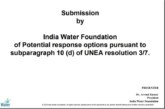Barriers to combating marine litter and microplastics, including challenges related to resources in developing countries:

As per the current situation and going through the existing and potential response, the current options and activities are not contributing enough with regard to marine litter and microplastics at global level.
The solution to addressing marine litter requires global and transboundary action like stated by Liberia before, that the UN Convention on the Law of the Sea only addresses some aspects of pollution in the protection of the marine environment.
It has been discussed previously by several representatives the difficulties faced in attempting to calculate and place a monetary value on the costs and benefits of various response options, particularly when including environmental and social costs in addition to economic costs.
For some countries like Bangladesh, the alternatives to plastic carrier bags had proved to be more expensive, in fact the US studies have shown that the price for alternatives to some plastics can be as high as four times, and noted that some alternatives also contain harmful substances.
Range of national, regional and international response options, including actions and innovative approaches, and voluntary and legally binding governance strategies and approaches:
The adoption of circular economy via Reduce reuse and recycling is one of the most effective tool to combat pollution. Private sector should be encouraged and engaged to introduce recycling effectively.
Here I would cite examples of some countries like Eritrea had discussed measures to reduce and eliminate marine plastics through legislation and regulatory enforcement. Liberia underscored the need for cost effective solutions to reduce marine litter in order to ensure sustainability. Haiti had called for a more holistic approach, involving regional and international cooperation.
And for India after attending the AHEG meetings in Geneva and Bangkok respectively we shared the lessons learnt with the Hon’ble minister of earth Sciences and to take on the marine pollution across India’s 7,500 km coastline the ministry begin work on a comprehensive study to identify the source of litter, especially the plastic waste that flows into India’s coastal waters. The exercise is the first step towards framing a National Marine Litter Policy with the objective to clean up the oceans, which is in line with UN Environment’s global ‘Clean Seas Campaign’
There is a noted consensus on the impacts of global microplastics contamination and their effects on the environment and human health, there is the need for urgent action based on current research and understanding. The chemical additives in plastics are hazardous to human health and the environment.
Feasibility and effectiveness of different response options above:
The UN Environment Assembly established an Ad Hoc Open-Ended Expert Group to explore all barriers to combating marine litter and microplastics with the emphasis on the importance of strengthened coordination and multi-stakeholder cooperation for achieving long-term elimination of plastic discharge into the oceans. Its role should be further strengthened.
A new legally bound convention should be adopted on plastic pollution.
Potential options for continued work for consideration by the United Nations Environment Assembly:
New legally binding instrument is still not an ideal solution due to the time it takes to negotiate a new instrument, citing the 13-year negotiations towards a legally binding instrument under UNCLOS on the conservation and sustainable use of marine biological diversity.
Countries must foster a coordinated governance strategy towards a more holistic view of the cause-effect pathways, evaluate socio-economic environmental consequences, strengthen awareness and share knowledge, share innovations and case studies, technology transfer, adopt circular principles and enhance capacity building to address the issue of marine plastic litter and microplastics.
Countries should come to a consensus to tackle plastic pollution and incorporate environmentally sound best practices within the national context. Two-thirds of the plastic pollution entering our oceans from across the world come from the 20 most polluting rivers, out of 10 highest polluting rivers, Ganga stands 2nd this is not surprising when India annually dumps 6 lakh tonnes of plastic which finally enters the oceans and with a vast India’s coastline of 7516.6 km stopping plastic waste from entering the ocean is a huge challenge. NGO’s like us are constantly working among grass roots, communities residing on the banks of rivers and along the coasts line to inculcate behavioural change and create awareness about plastic use and marine litter. For example in India the northeastern state of Sikkim was the first state to ban plastics bottles & disposable foam products to reduce its plastic footprint and manage its waste in a more efficient and eco-friendly manner.
PART II
Going through the existing and potential response, the current options and activities are not contributing enough with regard to marine litter and microplastics at global level.
New legally binding instrument is still not an ideal solution due to the time it takes to negotiate a new instrument, citing the 13-year negotiations towards a legally binding instrument under UNCLOS on the conservation and sustainable use of marine biological diversity. For example, stressing that the solution to addressing marine litter requires global and transboundary action, Liberia had noted before that the UN Convention on the Law of the Sea (UNCLOS) only addresses some aspects of pollution in the protection of the marine environment. Eritrea too had discussed measures to reduce and eliminate marine plastics through legislation and regulatory enforcement and working with the private sector to introduce recycling. Liberia underscored the need for cost effective solutions to reduce marine litter in order to ensure sustainability. Haiti had called for a more holistic approach, involving regional and international cooperation.
It has been discussed previously by several representatives the difficulties faced in attempting to calculate and place a monetary value on the costs and benefits of various response options, particularly when including environmental and social costs in addition to economic costs.
For some countries like Bangladesh, the alternatives to plastic carrier bags had proved to be more expensive. The US showed studies have shown that the price for alternatives to some plastics can be as high as four times, and noted that some alternatives also contain harmful substances. Another NGO
Major Group noted the consensus on the impacts of global microplastics contamination and their effects on the environment and human health, stressing the need for urgent action based on current research and understanding. The chemical additives in plastics are hazardous to human health and the environment.
Update on submissions received on potential response options pursuant to UNEA Resolution 3/7 subparagraph 10(d).
Relevant documents: Submissions on potential options for continued work for consideration by the United Nations Environment Assembly (Provisional document)
Click Here


